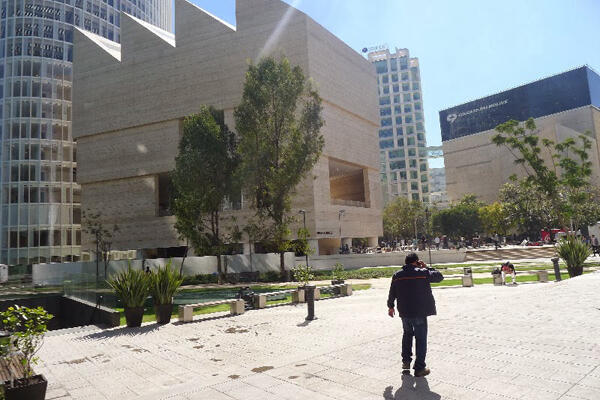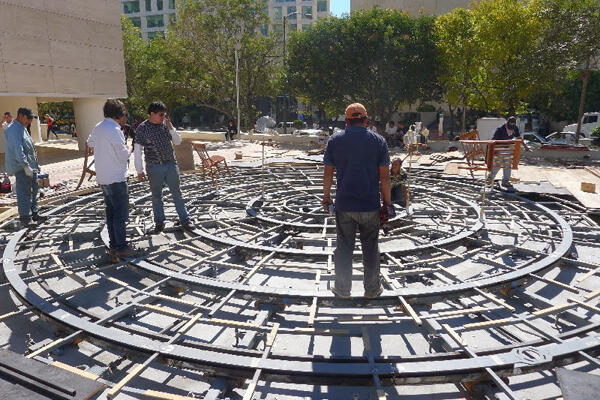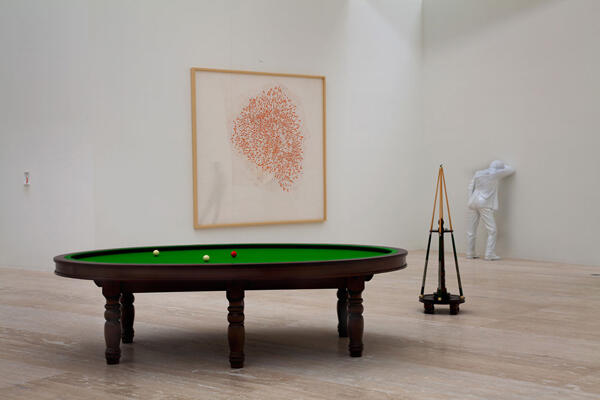The Jumex Foundation/Collection Opens its New Museum
Jumex Foundation/Collection, established by Eugenio López, opened its new Jumex Museum in Mexico City.

Designed by David Chipperfield Architects, the museum, located between Miguel de Cervantes Saavedra Boulevard, Ferrocarril de Cuernavaca Street, and Lago Zurich Street, will host one of Latin America’s most important contemporary art collections.
For its inaugural program, the museum is presenting 4 large-scale exhibitions:
1. The exhibition “ A Place in Two Dimensions: A Selection of the Jumex Collection + Fred Sandback”. This exhibition presents two independent art exhibitions woven into a single space. The first includes a large number of works by artists: Doug Aitken, Francis Alÿs, Carl Andre, Richard Artschwager, John Baldessari, Alighiero Boetti, Carol Bove, Maurizio Cattelan,Abraham Cruzvillegas, Minerva Cuevas, Urs Fischer, Peter Fischli & David Weiss, Robert Gober, Damien Hirst, Roni Horn, Jasper Johns, Donald Judd, On Kawara, Mike Kelley, Jeff Koons, Gonzalo Lebrija, Sarah Lucas, Teresa Margolles, Paul mcCarthy, Gabriel Orozco, Richard Prince, Thomas Ruff, Robert Ryman, Rudolph Stingel, Eduardo Terrazas, Jeff Wall, and Andy Warhol. The second exhibition includes Fred Sandback’s minimalist sculptures in thread.
The concept of this project departs from the reformulation of the theory of parallel universes and the principle of simultaneous dimensions that establishes that two or more physical objects, realities, or perceptions can coexists within the same time and space. The curatorial text states: “Today we know that the system in which we live does not operate linearly, since events do not occur in line, one after another. Our world is structured from multiple lines, as in an audio tape that contains multiple layers within the same track. On this track, the parallels Channel 1 and Channel 2, are still invisible to each other, but real and tangible for someone who perceives this as a whole. Thus, we can understand that the cosmic universe also runs on two or more strips of reality.
2. “James Lee Byars: ½ an Autobiorgraphy”, co-organised by Jumex’s curator Magali Arriola and the MoMA/PS1 curator Peter Eleey, will travel to the New York museum in June 2014. At the age of thirty-seven, in a time where that was half the average life expectancy age- James Lee Byars (Detroit, 1932 - Cairo, 1997) wrote his "Half Autobiography". Sitting in a gallery, he wrote down thoughts and questions every time a visitor would come to him, which he subsequently published in a book that was also titled "The Great Byars Exhibition". Throughout his life, Byars built a myth around his person, weaving himself into a continuous performance that made him one of the most iconic and provocative artists of the second half of the 20th century. “James Lee Byars: Half an Autobiography ” includes a selection of sculptures, cloth costumes, artworks in paper for performance, video, ink paintings, correspondence, ephemeral material, performance, and documentation that emphasizes Byars' work as an event. This exhibition —the most comprehensive sample of James Lee Byars organized by a museum in North America since his death— explores Byars’s absence, while at the same time emphasizing the inevitably incomplete nature of any exhibition that summarizes the life of an artist.
Obsessed with the idea of perfection, Byars created an impressive body of work consistent with the pursuit of beauty and truth. Guided by what he called "the first fully interrogative philosophy", he proposed an art made on scales ranging from the vastness of outer space to the microscopic level of subatomic particles, trying to delineate the limits of our knowledge while at the same time embodying a desire for something more.
3. “Domestic Cosmonogy”, by Damián Ortega curated by Rosario Nadal. The perpetual motion of “Domestic Cosmogony” and its ever-changing choreography produce ephemeral associations between elements that compose it and the public, triggering an ongoing reassessment of the space around us. The set of pieces that make up this work creates a kind of self-constructed mythology or epic spanning regions and ways of doing things as diverse as the work of Damián Ortega. Pieces ranging from the heroism of softening a Marie biscuit and achieving its distension (an exercise to pervert its integrity and dilute its physical composition, by dipping it into a cup of coffee), to the banal gesture of breaking up an object more current than common - a Sedan car released of its duties- to finally leave aside the utility and the modest compromises of efficiency and effectiveness of an articulated whole, and to suggest an intercommunication system: "the cosmic thing". This work surprises with its infinite interest in the tiny space that represents the artist’s apartment, an immediate environment that involves the deep knowledge of the worn carpet, the erotic properties of the washing machine, the geometry of the refrigerator, the theology encrypted in the sink. The stars are aligned; private and public spaces are finally combined. On this occasion, the work is placed on the outside, and lived as if it inhabited the interior of a home.
4. “Gamboa’s Ideas” curated by Mauricio Marcin. An expository exercise —comprised of three components— which stems from collaborative research between The Jumex Foundation of Contemporary Art and the Fernando Gamboa Cultural Promoter, an organization that maintains and manages Fernando Gamboa’s file. The first component is a printed volume showing various cultural operations realized by Fernando Gamboa: exhibitions, efforts to increase the public assets of Mexico, bureaucratic efforts to professionalize the practice of museology, and research travel records coming from his archive. The second component is an exhibition titled “People looking at art”, partially occupying the space assigned for the Jumex Museum Library. In this space, benches and potted plants were added to create waiting and rest areas. In this environment, reproductions of photographs of exhibitions organized by Fernando Gamboa are exhibited. The visitor’s guide can be found on the benches. This sample can be conceived as an exhibition, as well as printed support. The third component is the realization of a series of events: projections of audio-visual material, discussions tables and workshops, amongst others. The three components of this exhibition explore different ways to present and disseminate the information and documentation contained in the file of Fernando Gamboa.







